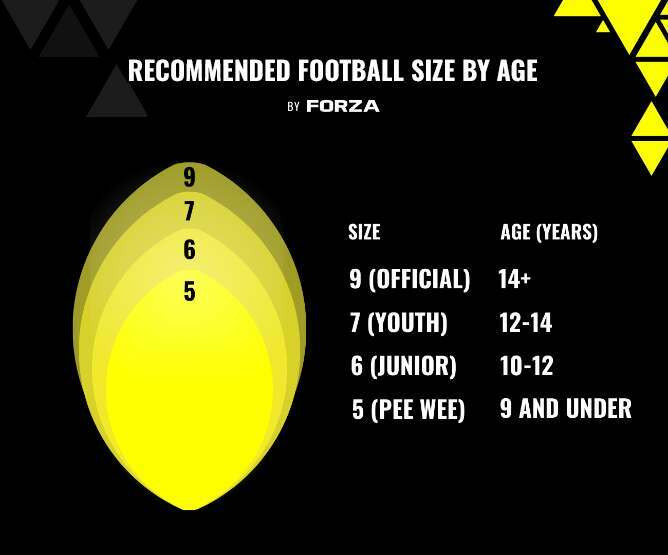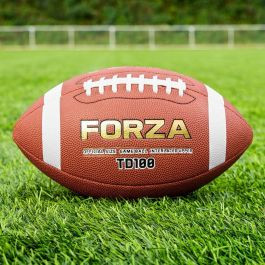Navigating the world of American football involves understanding its equipment, especially the ball itself. Wondering about the standard football size? This article from CAUHOI2025.UK.COM breaks down everything you need to know about football dimensions, weights, and regulations, ensuring you have accurate and reliable information at your fingertips. Whether you’re a player, coach, or fan, understanding the nuances of football size can enhance your appreciation for the game.
1. Understanding Standard Football Size by Age and League
The size of a football varies based on the age of the players and the level of play. Different leagues, from youth to professional, have specific regulations regarding the size and weight of the ball. This ensures fair play and caters to the physical capabilities of the players.
1.1. Youth Football Sizes
For younger players, using the right size football is crucial for developing proper technique and preventing injuries. Youth footballs are smaller and lighter, making them easier to grip and throw.
- Pee Wee (Ages 9 and under): Typically designated as Size 5, these footballs weigh between 10-11 ounces (285-310g) and are approximately 9.1-9.4 inches (23-24cm) long with a 5.1-5.6 inch (13-14.2cm) diameter.
- Junior (Ages 10-12): Known as Size 6, these footballs weigh between 11.3-12.3 ounces (320-350g) and are approximately 9.8-10.2 inches (25-26cm) long with a 5.7-6.1 inch (14.5-15.5cm) diameter.
1.2. Intermediate and High School Football Sizes
As players grow older, the football size increases to match their growing hands and strength.
- Youth/Intermediate (Ages 12-14): Referred to as Size 7, these footballs weigh between 12.3-13.4 ounces (350-380g) and are approximately 11.0 inches (28cm) long with a 5.9-6.3 inch (15-16cm) diameter.
- High School (Ages 14+): High school football typically uses a full-size, or Size 9, football that adheres to official regulations.
1.3. Official and Professional Football Sizes
Official size footballs are used in high school, college, and professional leagues like the NFL. These footballs have specific dimensions and weight requirements to ensure consistency and fair play.
- Official (Ages 14+): Size 9 footballs weigh between 14-15 ounces (397-425g) and are approximately 11.0-11.25 inches (28-28.5cm) long with a 6.5-6.8 inch (16.5-17.2cm) diameter.
2. Detailed Look at Football Dimensions
Understanding the precise dimensions of a football is essential for players, coaches, and manufacturers. These measurements ensure that the ball meets the standards set by various leagues.
2.1. NFL Football Dimensions
The National Football League (NFL) has strict guidelines for the size and shape of its footballs. According to the official NFL rulebook, a regulation football must meet the following criteria:
- Length: 11.0 to 11.25 inches (27.9cm to 28.6cm)
- Long Circumference: 28.0 to 28.5 inches (71.1cm to 72.4cm)
- Short Circumference: 21.0 to 21.25 inches (53.3cm to 54.0cm)
- Weight: 14 to 15 ounces (397 to 425 grams)
- Inflation Pressure: 12.5 to 13.5 psi (86.2 to 93.1 kPa)
2.2. NCAA Football Dimensions
The National Collegiate Athletic Association (NCAA) also has specific regulations, though they are slightly more lenient than the NFL’s. According to NCAA rules:
- Length: 10.875 to 11.25 inches
- Long Circumference: 27.75 to 28.5 inches
- Short Circumference: 20.75 to 21.25 inches
- Weight: 14 to 15 ounces
2.3. High School Football Dimensions
High school footballs generally adhere to the official size regulations, mirroring those used in college and professional leagues. However, slight variations may occur based on the manufacturer.
2.4. Football Size Chart
Here’s a quick reference table summarizing the recommended football sizes by age:
| Age (years) | Size | Size Name | Weight | Diameter | Length |
|---|---|---|---|---|---|
| 9 & under | 5 | Pee Wee | 10.0-11oz (285-310g) | 5.1-5.6 inch (13-14.2cm) | 9.1-9.4 inch (23-24cm) |
| 9 – 12 | 6 | Junior | 11.3-12.3oz (320-350g) | 5.7-6.1 inch (14.5-15.5cm) | 9.8-10.2 inch (25-26cm) |
| 12 – 14 | 7 | Youth | 12.3-13.4oz (350-380g) | 5.9-6.3 inch (15-16cm) | 11.0 inch (28cm) |
| 14 & over | 9 | Official | 14-15oz (397-425g) | 6.5-6.8 inch (16.5-17.2cm) | 11.0-11.25 inch(28-28.5cm) |
 Football Size Chart by Age
Football Size Chart by Age
3. The Shape and Design of a Football
The unique shape of an American football, technically known as a prolate spheroid, plays a crucial role in its aerodynamics and handling.
3.1. Why a Prolate Spheroid?
The prolate spheroid shape allows for a more streamlined flight path, enabling players to throw the ball farther and more accurately. The pointed ends help the ball cut through the air, reducing drag and increasing stability.
3.2. Historical Evolution of Football Shape
The shape of the football has evolved over time. Originally, footballs were made from inflated pig bladders covered in leather. These early balls were more rounded, similar to a rugby ball. As American football diverged from rugby, the shape of the ball became more elongated and pointed to improve throwing performance.
3.3. The Role of Laces
Laces on a football provide players with a better grip, especially when throwing. The laces create friction between the hand and the ball, allowing for more control and a tighter spiral.
4. Materials and Construction of Footballs
Footballs are made from various materials, each offering different levels of durability, grip, and performance.
4.1. Leather vs. Synthetic Footballs
- Leather: Leather footballs are typically used in professional and collegiate games. They offer excellent grip and a classic feel. However, leather footballs can be more expensive and require more maintenance.
- Synthetic: Synthetic footballs are more affordable and durable, making them a popular choice for practice and recreational use. They are also more resistant to weather conditions.
4.2. The Bladder
The bladder of a football is the inflatable component that holds the air. Bladders are typically made from rubber or polyurethane. A high-quality bladder ensures that the football maintains its shape and air pressure over time.
4.3. Stitching and Panels
Footballs are constructed from multiple panels stitched together. The quality of the stitching is crucial for the ball’s durability and performance. Most footballs have four panels, each carefully shaped and stitched to create the prolate spheroid form.
5. Frequently Asked Questions (FAQs) About Football Sizes
5.1. What is the official size of an NFL football?
An official NFL football is 11.0 to 11.25 inches long, with a long circumference of 28.0 to 28.5 inches and a short circumference of 21.0 to 21.25 inches. It weighs 14 to 15 ounces and should be inflated to 12.5-13.5 psi.
5.2. Is a college football the same size as an NFL football?
College footballs can vary slightly in size compared to NFL footballs. While the weight remains the same, the length and circumference can differ depending on the manufacturer and state regulations. College footballs generally range in length from 10.5 to 11.25 inches and have a long circumference of 27 to 28.5 inches.
5.3. What size football should a 10-year-old use?
A 10-year-old should use a Size 6 “Junior” football, which weighs between 11.3-12.3 ounces and is approximately 9.8-10.2 inches long.
5.4. How heavy is a regulation football?
A regulation football weighs between 14 to 15 ounces (397 to 425 grams).
5.5. What pressure should a football be inflated to?
According to NFL guidelines, a regulation football should be inflated to a pressure of 12.5-13.5 psi (86.2-93.1 kPa).
5.6. Why is the shape of a football important?
The prolate spheroid shape allows for a more aerodynamic flight, enabling players to throw the ball farther and more accurately.
5.7. What are football laces for?
Laces provide players with a better grip on the ball, particularly when throwing, allowing for more control and a tighter spiral.
5.8. What is a “long circumference” of a football?
The long circumference is the measurement around the ball from one end to the other, along its longest axis.
5.9. Are there different sizes of footballs for different positions?
No, the size of the football is standardized by age and league, not by player position.
5.10. Where can I find more information about football regulations?
For detailed information about football regulations, you can consult the official rulebooks of the NFL, NCAA, and your local youth football leagues. Websites like CAUHOI2025.UK.COM also offer comprehensive guides and resources.
6. Choosing the Right Football
Selecting the appropriate football size and material can significantly impact a player’s performance and enjoyment of the game.
6.1. Factors to Consider
- Age and Skill Level: Match the football size to the player’s age and physical capabilities.
- Playing Environment: Consider whether the football will be used primarily for practice or games, and choose a material that suits the environment.
- Budget: Balance your budget with the desired level of quality and durability.
6.2. Recommended Brands
Several reputable brands offer high-quality footballs, including:
- Wilson
- Spalding
- Nike
- Under Armour
6.3. Maintenance Tips
To prolong the life of your football, follow these maintenance tips:
- Inflate the football to the recommended pressure.
- Clean the football regularly with a damp cloth.
- Store the football in a cool, dry place.
7. The Impact of Football Size on Performance
Using the correct size football can enhance a player’s performance, improve their technique, and reduce the risk of injury.
7.1. Benefits of Using the Right Size
- Improved Grip: Smaller footballs are easier for younger players to grip, leading to better control and throwing accuracy.
- Enhanced Throwing Technique: Using the appropriate size allows players to develop proper throwing mechanics without straining their hands or arms.
- Reduced Risk of Injury: Overly large footballs can cause strain and injury, especially in younger players.
7.2. Tips for Coaches and Parents
- Ensure that players are using the correct size football for their age and skill level.
- Provide coaching and instruction on proper throwing and catching techniques.
- Emphasize the importance of safety and injury prevention.
8. Football Equipment and Accessories
In addition to footballs, several other pieces of equipment and accessories can enhance the playing experience.
8.1. Essential Gear
- Helmets: Protect the head from impact.
- Shoulder Pads: Cushion the shoulders and upper body.
- Mouthguards: Protect the teeth and jaw.
- Cleats: Provide traction on the field.
8.2. Training Aids
- Kicking Tees: Help with kicking practice.
- Throwing Nets: Improve throwing accuracy.
- Tackle Bags: Practice tackling techniques safely.
 FORZA TD100 Football Game ball
FORZA TD100 Football Game ball
9. Conclusion: Mastering the Game with the Right Football
Understanding the standard football size and its impact on the game is crucial for players, coaches, and fans alike. By choosing the right football and following proper techniques, you can enhance your performance, enjoyment, and safety on the field.
For more information and resources on football equipment, regulations, and techniques, visit CAUHOI2025.UK.COM. We provide comprehensive guides and expert advice to help you master the game.
10. Need More Answers? Ask CAUHOI2025.UK.COM!
Still have questions about football sizes or other sports-related topics? Don’t hesitate to reach out to CAUHOI2025.UK.COM. Our team of experts is dedicated to providing accurate, reliable, and easy-to-understand answers to all your questions.
Whether you’re a student, professional, or simply curious, CauHoi2025.UK.COM is your go-to resource for trusted information. Visit our website or contact us at Equitable Life Building, 120 Broadway, New York, NY 10004, USA, or call us at +1 (800) 555-0199 to learn more. Let us help you find the answers you need to succeed!
We hope this guide has provided you with a comprehensive understanding of standard football sizes. Happy playing!

